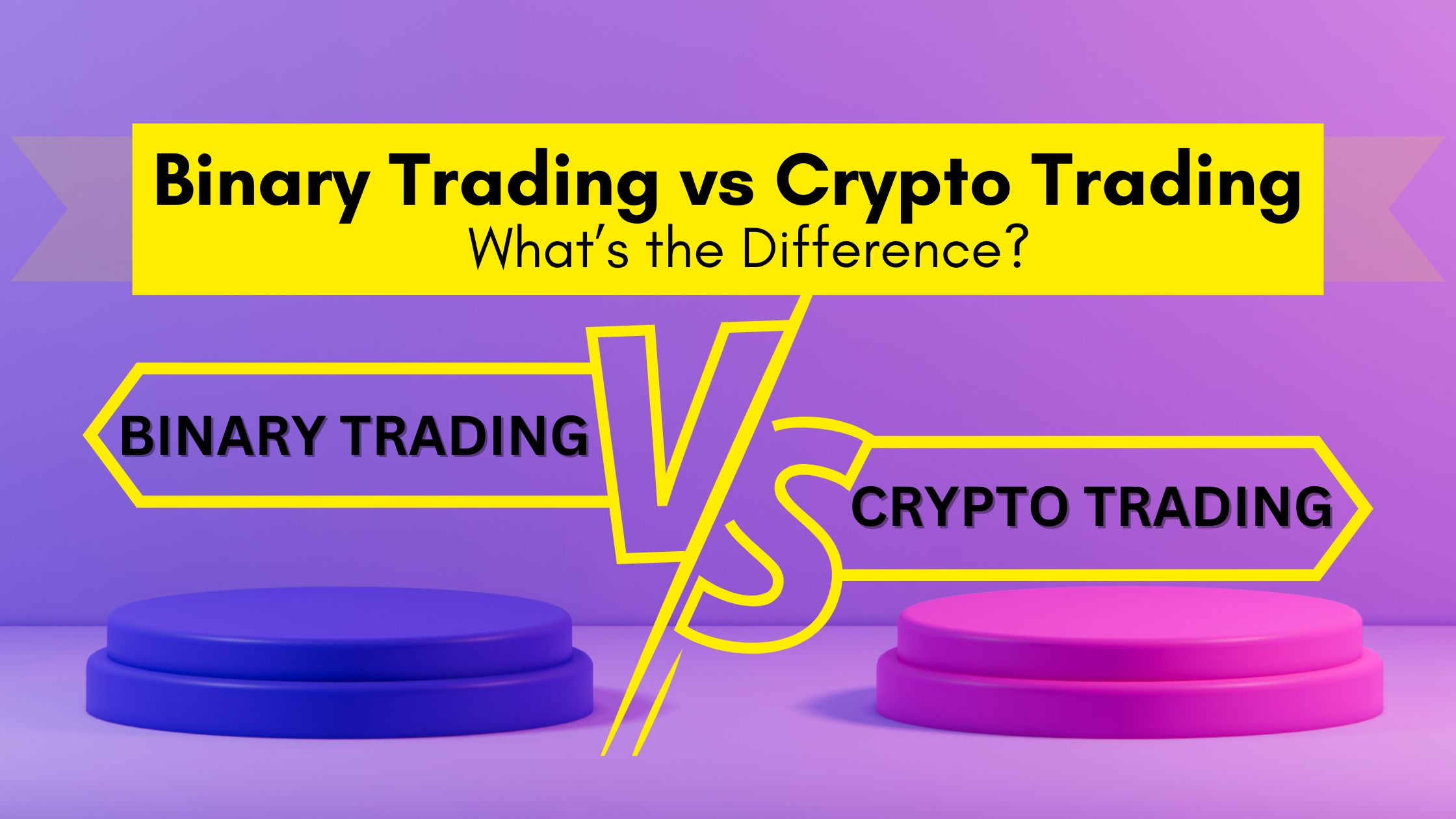Binary Trading vs Crypto Trading: With the world of trading becoming more diverse by the day, newcomers are often met with many options, making it challenging to discern which investment route to take. “binary trading vs crypto trading” is a scorching topic among these options. This article dives deep into the core distinctions between these two trading forms, providing a comprehensive guide for those seeking clarity.
Table of Contents
What is Binary Trading and how it works?
Binary trading, also known as binary options trading, is a form of financial trading where you predict the price movement of an asset within a specified time frame. The word “binary” signifies the dual outcome of this trading method:
- Call/Put (or High/Low): Traders predict whether the price of the asset will rise (Call/High) or fall (Put/Low) by the end of a predetermined time frame.
- Outcome: If the trader’s prediction is correct, they receive a fixed payout. If they’re wrong, they lose the amount they invested.
Here’s a basic overview:
- Underlying Asset: The asset (e.g., stock, forex pair, commodity) on which the prediction is based.
- Expiration Time: The specified time frame after which the option expires. This can range from seconds to hours, days, or even weeks.
- Strike Price: The underlying asset’s price when the binary option is initiated.
Binary trading can be simple to understand since the outcome is binary – either you win and get a predefined payout or lose your initial investment. However, it’s essential to note that many view it as speculative and risky, especially without proper understanding and strategy.
What is Crypto Trading and how it works?
Crypto trading, or cryptocurrency trading, refers to the act of buying, selling, or exchanging cryptocurrencies. Given the decentralized nature of these digital assets, crypto trading typically occurs on cryptocurrency exchanges. Here are the fundamental aspects:
- Spot Trading: This is the most common form of crypto trading, where individuals buy and sell actual cryptocurrencies like Bitcoin, Ethereum, or any of the thousands of other coins and tokens.
- Futures & Derivatives Trading: Some platforms allow for trading futures contracts or derivatives based on the future price of a cryptocurrency. This is more complex and might involve leveraging one’s positions.
- Exchange Mechanism:
- Centralized Exchanges (CEX): Platforms operated by centralized organizations facilitating trading. Examples include Binance, Coinbase, and Kraken.
- Decentralized Exchanges (DEX): Platforms that operate without a central authority using smart contracts, allowing users to trade directly from their wallets. Examples include Uniswap and SushiSwap.
- Wallets: To store and manage their cryptocurrencies, traders use digital wallets, which can be hardware-based (cold wallets) or software-based (hot wallets).
Crypto trading can be highly volatile, with prices of cryptocurrencies experiencing significant fluctuations within short time frames. While this volatility can offer profit opportunities, it also comes with increased risk. As with any trading, understanding the market, doing proper research, and having a clear strategy are crucial for success.
Binary Trading vs Crypto Trading: A Deeper Dive
Nature of the Asset in Binary Trading vs Crypto Trading
Binary Trading
Binary trading is a financial instrument that lets traders predict the price movement of assets such as stocks, commodities, or forex pairs. Notably, when engaging in binary trading, investors don’t actually purchase the asset. Instead, they bet on its price movement, taking a ‘yes’ or ‘no’ position.
Crypto Trading
On the other hand, crypto trading involves the buying and selling of cryptocurrencies such as Bitcoin, Ethereum, and numerous altcoins. Unlike binary trading, investors in the crypto market do own the digital currencies they buy, and they can transfer or use them based on their needs.
Trade Duration
Binary Trading
Generally, binary trading is short-term. Traders place bets on whether an asset’s price will rise or fall within a set timeframe. These periods can range from a mere 60 seconds to several weeks.
Crypto Trading
Crypto trading offers more flexibility in terms of duration. While some traders opt for short-term day trading to capitalize on price fluctuations, others take a long-term approach, holding onto their assets for years.
Payout Structure
Binary Trading
Binary trading offers fixed payouts. If a trader’s prediction aligns with the asset’s actual movement, they receive a predetermined payout, often between 70-90% of the investment. However, a wrong prediction means losing the entire investment.
Crypto Trading
In the crypto world, the profits or losses aren’t fixed. It all depends on the cryptocurrency’s buying and selling price. Profits come from buying low and selling high, whereas losses stem from doing the opposite.
Regulatory Landscape
Binary Trading
Binary options trading may fall under financial regulations, depending on the region. However, traders should exercise caution as many platforms have fraudulent operations. Always choose a reputable broker.
Crypto Trading
Crypto regulations vary significantly across countries. As the sector evolves, governments continuously update their stance, with some embracing the technology and others imposing restrictions or outright bans.
Risk Profile
Binary Trading
Due to its all-or-nothing nature, binary trading carries a high risk. The speculative aspect, combined with potential total losses, means traders should approach this market with caution.
Crypto Trading
Crypto trading, too, is high-risk, primarily because of the notorious volatility associated with cryptocurrencies. The 24/7 operation of the market further intensifies potential price swings.
Utility Differences
Binary Trading
Binary options exist purely as financial instruments for trading. They don’t possess any utility beyond that.
Crypto Trading
Cryptocurrencies, in contrast, often have real-world applications. Bitcoin facilitates peer-to-peer transactions, Ethereum powers smart contracts, and other altcoins bring diverse utilities.
Underlying Technology
Binary Trading
Binary trading platforms are mainly built on traditional web technologies, backend databases, and servers. They rely on market data providers to fetch the underlying assets’ real-time or near-real-time price information.
Crypto Trading
The backbone of crypto trading is blockchain technology—a decentralized, distributed ledger system. Every transaction is recorded on this ledger, providing transparency and security. Cryptocurrencies like Bitcoin and Ethereum have their own unique blockchains, while others might run on existing platforms like the Ethereum blockchain (known as ERC-20 tokens).
Market Operations
Binary Trading
Most binary options brokers operate during specific hours, aligning with stock market hours or other financial market timings. There’s usually a centralized authority or broker overseeing and facilitating the trades.
Crypto Trading
Cryptocurrency markets operate 24/7 with no central authority. Trades happen directly between users or through decentralized platforms, although centralized crypto exchanges like Binance or Coinbase are popular for their ease of use.
Security Measures
Binary Trading
Binary trading platforms generally employ standard cybersecurity measures like SSL certificates, two-factor authentication, and data encryption. However, the centralized nature of their operations can make them targets for hacking.
Crypto Trading
Cryptocurrencies lean heavily on cryptographic security, which is inherent in blockchain technology. Wallets, both hot (online) and cold (offline), are used to store crypto assets. While crypto exchanges can be hacked, blockchain’s decentralized nature makes it resilient against attacks. Private keys, representing cryptocurrency ownership, provide an added layer of security but also come with the responsibility of safekeeping.
Entry Barriers and Accessibility
Binary Trading
There’s often a minimum deposit required to start trading binary options set by the broker. While online platforms have made access easier, some regions restrict or ban binary trading due to regulatory concerns.
Crypto Trading
Crypto trading is more democratized. Anyone can create a cryptocurrency wallet and start trading with an internet connection. Some platforms might have minimum trading volumes, but the threshold is generally low. Moreover, it’s a global market with fewer geographical restrictions.
Asset Liquidity
Binary Trading
Liquidity in binary trading is often determined by the broker’s ability to match buyers and sellers. In less popular markets or during off-hours, this might be challenging.
Crypto Trading
Given the global and round-the-clock nature of crypto trading, there’s typically high liquidity, especially for prominent cryptocurrencies. However, newer or less-known altcoins might need more liquidity.
Binary Trading vs Crypto Trading: Table View:
| Aspect | Binary Trading | Crypto Trading |
| Nature of the Asset | Bet on price movement of assets like stocks, commodities, or forex. No actual purchase of the asset. | Buying and selling of actual cryptocurrencies. Ownership, transfer, and usage of digital currencies. |
| Trade Duration | Typically short-term. Predictions range from 60 seconds to several weeks. | Flexible: Can be short-term (day trading) or long-term (years). |
| Payout Structure | Fixed payouts. Correct predictions earn 70-90% of the investment. Wrong ones lose the entire investment. | Profits or losses based on buying and selling price. Not fixed. |
| Regulation | May be regulated depending on the region. High presence of fraudulent platforms. | Varies by country. Some embrace, others restrict or ban cryptocurrencies. Rapidly evolving regulatory landscape. |
| Risk Profile | High due to all-or-nothing nature. | High due to cryptocurrency volatility and 24/7 market operation. |
| Utility | Exists solely as a financial instrument for trading. | Cryptocurrencies have real-world applications e.g., transactions (Bitcoin), smart contracts (Ethereum), etc. |
This table provides a clear difference in Binary Trading vs Crypto Trading, at-a-glance summary of the main distinctions between binary trading and crypto trading. It’s always beneficial to dive deeper into each aspect when considering an investment in either realm.
Also read this Blog: Top 9 Crypto Swap Platforms for 2023: An In-Depth Review
Conclusion
Understanding the intricacies of different trading methods is paramount in the evolving financial trading landscape. While both binary and crypto trading present potential avenues for profit, they cater to various risk appetites and require varying degrees of expertise.
With its fixed payout structure, binary trading offers a relatively straightforward approach. It hinges on predicting asset movements over short periods, making it suitable for those who prefer quick outcomes. However, the all-or-nothing nature of this trading method means that careful strategy and risk management are essential.
On the other hand, crypto trading plunges traders into the dynamic world of digital currencies underpinned by revolutionary blockchain technology. Cryptocurrencies are vast, from straightforward spot trading to the more complex derivatives market. The 24/7 market operations, global accessibility, and potential for high returns make it attractive. Yet, the volatility inherent in this market necessitates a well-informed and cautious approach.
Whether you lean towards binary options or the cryptocurrency market, the key lies in continuous education, diligent research, and strategic planning. Both avenues come with unique challenges, but with the right mindset and tools, they can offer rewarding opportunities for the discerning trader. As the financial world transforms, staying informed and adaptable will always be the trader’s most valuable asset.





 Bitcoin
Bitcoin  Ethereum
Ethereum  XRP
XRP  Tether
Tether  USDC
USDC  Lido Staked Ether
Lido Staked Ether